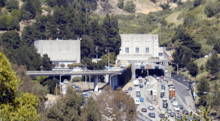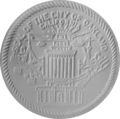Caldecott Tunnel
 The Caldecott Tunnel, western end, before the construction of the fourth bore | |
| Overview | |
|---|---|
| Location | Oakland / Contra Costa County, California |
| Coordinates | 37°51′17″N 122°13′00″W / 37.8548°N 122.2166°W |
| Route |
|
| Operation | |
| Opened |
Bores 1 & 2: 1937 Bore 3: 1964 Bore 4: 2013 |
| Operator | Caltrans |
| Technical | |
| Length |
Bores 1 & 2: 3,610 ft (1,100 m) Bore 3: 3,771 ft (1,149 m) Bore 4: 3,389 ft (1,033 m) |
| Number of lanes | 2 per bore |
| Tunnel clearance |
Bore 1: 14.58 feet (4.44 m) Bore 2: 14.5 feet (4.4 m) Bore 3: 15.5 feet (4.7 m) Bore 4: 15.5 feet (4.7 m) |

The Caldecott Tunnel is a four-bore highway tunnel through the Berkeley Hills between Oakland, California and Orinda, California.
Description
The east-west tunnel is signed as a part of State Route 24 and connects Oakland to central Contra Costa County and is named after Thomas E. Caldecott (1878–1951), mayor of Berkeley from 1930–1932, member of the Alameda County Board of Supervisors 1933-1945, and president of Joint Highway District 13, which built the first two bores.
Bore 1 (the southernmost bore) and Bore 2 were completed in 1937 and are 3,610 feet (1,100 m) in length. Both carry two lanes each of eastbound traffic. Bore 3, completed in 1964, is 3,771 feet (1,149 m) in length. Bore 4 (the northernmost bore), completed in 2013, is 3,389 feet (1,033 m) in length. Bores 3 and 4 carry two lanes each of westbound traffic.
The active Hayward Fault runs just west of the western portals of the tunnel.[1]
History
In the 19th century, traffic over the Berkeley Hills in this area went up Harwood Canyon, now known as Claremont Canyon (behind the Claremont Hotel). The road leading up the canyon from the west was initially called Harwood's Road, later changed to Telegraph Road, and finally, Claremont. The road on the other side of the hills was, and remains, Fish Ranch Road. An inn and stage coach stop called the Summit House once existed at the summit.
The idea of a tunnel through the hills began as early as 1860. In that year, the idea was proposed and rejected by the citizens of Alameda and Contra Costa Counties. It was revived in 1871 with a proposal which described a route running from the end of Broadway, similar to the actual routing of today's Caldecott Tunnel although it is not clear from the description exactly which canyon was being referred to. The proposed tunnel would be only some 500 feet long and would have its outlet in the San Pablo Creek watershed with a road leading into Lafayette. A franchise was granted to a group of developers who passed the franchise onto another group. The proposal languished until the turn of the century.[2]
In 1903 a tunnel was finally built above the present location of the Caldecott Tunnel, in the next canyon south of Claremont Canyon. This tunnel was approached by a new road dubbed "Tunnel Road" which started at the top of Ashby Avenue in Berkeley. The west end of the tunnel was at about 37°51′22″N 122°12′49″W / 37.8561°N 122.2137°W while the east end of the tunnel is now in private property owned by the East Bay Regional Park District, on the former site of the Canary Cafe. This tunnel was known as the Kennedy Tunnel, the Inter-County Tunnel or the Broadway tunnel.[3] The tunnel was very narrow and arched, such that two tall buggies could not pass each other.[4] A system of lighting a small fire with a newspaper was used to control this one-way traffic. The tunnel height was increased in 1915 by 3 feet to accommodate larger vehicles.[5] When the new Caldecott tunnel was completed, the Kennedy tunnel was used mostly by pedestrians until it was sealed in 1947.[3]
Original twin bores
In 1929, construction of the first two bores of the Caldecott Tunnel began. They were completed in 1937 and were originally known as the Broadway Low Level Tunnel, as the approach was from the top of Broadway in Oakland, and was below the portal of the old tunnel. However, access from Ashby Avenue was retained as it was designated the connecting thoroughfare from the Eastshore Highway (now Freeway) and the San Francisco–Oakland Bay Bridge, and dubbed State Highway 24. The approach to the east portal on the other side of the Berkeley Hills was via Mount Diablo Boulevard, also at that time part of State Highway 24.
Third bore and traffic reversal
By the late 1950s, the Division of Highways upgraded the approach to the tunnel into a modern freeway. With Contra Costa County accessible by freeway, it quickly changed from a farming community and urban getaway into a major suburb.
The Division of Highways purchased sufficient right-of-way to the north of the existing twin bores to build another pair of bores. Given the traffic counts and the expense of tunnel construction, the construction of two additional bores would have been seen as unnecessary and extravagant. However, with the traffic count exceeding 50,000 vehicles per day, the state embarked on a project to build a third bore at the Caldecott Tunnel.
The project broke ground in 1960 and was completed by October 1964. When the third bore was opened, the other bores were closed one at a time for maintenance, including the installation of a continuous row of fluorescent lights. Eventually the new third bore made it possible to reverse the traffic flow of the middle bore, providing four lanes to accommodate the heavier commute-direction traffic.
The third bore also brought new technology to the tunnel with the installation of the "pop-up" lane control. Plastic lane delineators were set in tubes within the pavement. With the touch of a button, water would fill tubes to cause the delineators to pop up from the pavement; the middle bore was closed to one direction of travel, while opening it to another. During the week, the middle bore of the Caldecott was reversed between 2:00 am and 5:00 am to favor westbound traffic, and then switched again sometime between 11:30 am and noon to favor eastbound traffic. Ballgames, concerts and other events made balancing weekend traffic through the tunnel very difficult. It was not uncommon to reverse the middle bore six times on a Saturday or Sunday.
The pop-up system still required a lot of manpower to implement. While it did eliminate the need to set down individual cones to separate traffic, Caltrans maintenance workers had to direct traffic out of the closing lanes to prevent from vehicles getting caught on the wrong side of the pop-up delineators.[6]
In the late 1960s the Grove-Shafter Freeway was completed and replaced Broadway as the main route to the Caldecott Tunnel from Oakland as well as replacing Ashby for traffic coming from San Francisco. Ashby Avenue and Tunnel Road were redesignated State Highway 13 and aligned with the new Warren Freeway through the Montclair District of Oakland. The Grove-Shafter Freeway was then designated State Highway 24. In 1980, the freeway was renamed after William Byron Rumford.
Tunnel fire
On April 7, 1982, an accident involving a gasoline tanker truck in the third (then-northernmost) bore set off the Caldecott Tunnel fire.[7] The accident caused major damage, and the bore was closed to traffic for several months while repairs were made. During the fire, the tunnel acted as a natural chimney venting the smoke, flames and heat uphill towards the east side entrance to the tunnel. The accident and fire killed seven people, most of whom were overcome by toxic smoke. The fire occurred shortly after midnight when there were few cars in the tunnel; had it occurred during normal commute hours, hundreds could have died. As a result of the fire, it is now illegal to transport hazardous material in a tanker truck through the tunnel except between the light traffic hours of 3:00 am and 5:00 am.[8]
In October 1991, the catastrophic Oakland firestorm started on the ridge north of the Caldecott Tunnel. The fire spread quickly west down both sides of the west portal of the tunnel on its way to killing 25 and destroying over three thousand homes, apartments and condominiums. The Caldecott Tunnel was designated a City of Oakland Landmark in 1980, and later received a Preservation Award from the Art Deco Society of California in 1993.
Fourth bore
To relieve traffic congestion in the reverse commute direction, the California Department of Transportation began planning for a fourth bore in 2000. In 2007, the California Transportation Commission approved the final funding needed to build the fourth bore.[9] Construction started in 2010[10] and lasted until 2013.[11][12][13]
The fourth bore contains a roadway with one 10-foot-wide (3.0 m) and one 2-foot-wide (0.6 m) shoulder, a 3-foot-wide (0.9 m) walkway, ventilation, air and traffic monitoring systems, traffic lights, and electronic message boards.[14] There are emergency exits to the third bore. When the fourth bore was opened to traffic, the need for the daily traffic reversal was eliminated; two bores (four lanes) serve both directions at all times, although individual tubes may be closed during periods of light use for maintenance purposes.[15]
Weather phenomena
Weather conditions can vary greatly from one end of the tunnel to the other. In summer, for example, motorists may enter the tunnel from the east where it is sunny and warm, and emerge on the west end into fog and cold. In winter, during spells of inland tule fog, the reverse can occur.[16][17]
See also
- Berkeley Hills Tunnel — BART rail transit tunnel, running approximately parallel to the Caldecott Tunnel
References
- ↑ "Digital Map of Recently Active Traces of the Hayward Fault, California". earthquake.usgs.gov. US Geological Survey. Retrieved 2016-11-26.
- ↑ History of Contra Costa County, California. W.A. Slocum and Company. 1882. p. 451. Retrieved January 23, 2010.
- 1 2 Rafkin , Louise (October 1, 2011). "Local Intelligence: Kennedy Tunnel". Bay Citizen. Retrieved October 8, 2013.
- ↑ "Image: Tunnel 1903". Contra Costa County Historical Society. 1903. Retrieved October 8, 2013.
- ↑ "Lafayette: A Pictorial History". Lafayette Historical Society. Retrieved October 8, 2013.
- ↑ "History of the Caldecott". The Caldecott Tunnel Fourth Bore Project. Retrieved October 8, 2013.
- ↑ Martin, Murilee (April 16, 2007). "25 Years Since The Great Caldecott Tunnel Fire". Jalopnik. Retrieved January 23, 2010.
- ↑ "Vehicle Code Section 31301 - Caldecott Tunnel Restriction". California Department of Motor Vehicles. September 20, 1982. Retrieved January 23, 2010.
- ↑ "Corridor Mobility Improvement Account (CMIA) as adopted by California Transportation Commission (CTC) — February 28, 2007: San Francisco Bay Area Projects" (PDF). Metropolitan Transportation Commission. Retrieved January 20, 2014.
- ↑ Cabanatuan, Michael (January 23, 2010). "Work begins on Caldecott Tunnel's 4th bore". San Francisco Chronicle. Retrieved January 20, 2014.
- ↑ Cabanatuan, Michael (December 1, 2011). "Breakthrough for Caldecott Tunnel's new 4th bore". San Francisco Chronicle. Retrieved January 20, 2014.
- ↑ Cabanatuan, Michael (August 13, 2012). "Caldecott tunnel excavation completed". San Francisco Chronicle. Retrieved October 8, 2013.
- ↑ Cabanatuan, Michael (November 16, 2013). "Caldecott Tunnel fourth bore opens". San Francisco Chronicle. Retrieved January 20, 2014.
- ↑ Cardno, Catherine A. (February 2014). "Safe passage". Civil Engineering. American Society of Civil Engineers: 60–65.
- ↑ "Caldecott Tunnel Fourth Bore Project Schedule". The Caldecott Tunnel Fourth Bore Project. Retrieved October 8, 2013.
- ↑ "Keep Oakland Beautiful Point Of Interest: Caldecott Tunnel", Eric Saltmarsh, March 10, 2015, Keep Oakland Beautiful, Keep America Beautiful Affiliate
- ↑ Weather of the San Francisco Bay Area, by Harold Gilliam, University of California Press, 1962
External links
- California Department of Transportation website on the Caldecott Improvement Project
- Construction Photo (1936) of the West Portal, Contra Costa Historical Society
- Aerial View (1936) Showing Old and New Tunnels, Contra Costa Historical Society
Coordinates: 37°51′17″N 122°13′00″W / 37.8548°N 122.2166°W
